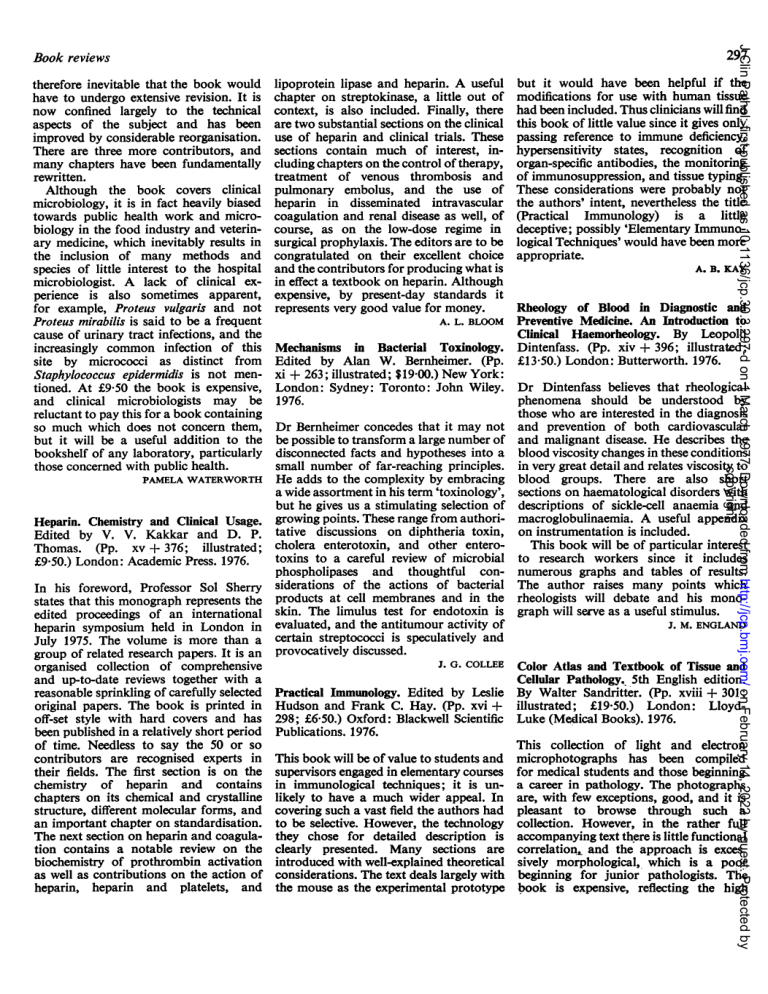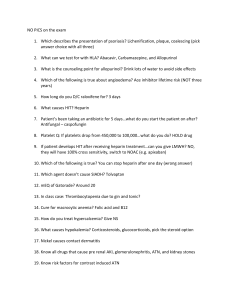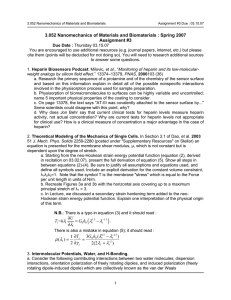
J Clin Pathol: first published as 10.1136/jcp.30.3.297-d on 1 March 1977. Downloaded from http://jcp.bmj.com/ on February 14, 2022 by guest. Protected by copyright. 297 Book reviews therefore inevitable that the book would have to undergo extensive revision. It is now confined largely to the technical aspects of the subject and has been improved by considerable reorganisation. There are three more contributors, and many chapters have been fundamentally rewritten. Although the book covers clinical microbiology, it is in fact heavily biased towards public health work and microbiology in the food industry and veterinary medicine, which inevitably results in the inclusion of many methods and species of little interest to the hospital microbiologist. A lack of clinical experience is also sometimes apparent, for example, Proteus vulgaris and not Proteus mirabilis is said to be a frequent cause of urinary tract infections, and the increasingly common infection of this site by micrococci as distinct from Staphylococcus epidermidis is not mentioned. At £9-50 the book is expensive, and clinical microbiologists may be reluctant to pay this for a book containing so much which does not concern them, but it will be a useful addition to the bookshelf of any laboratory, particularly those concerned with public health. PAMELA WATERWORTH Heparin. Chemistry and Clinical Usage. Edited by V. V. Kakkar and D. P. Thomas. (Pp. xv + 376; illustrated; £9-50.) London: Academic Press. 1976. In his foreword, Professor Sol Sherry states that this monograph represents the edited proceedings of an international heparin symposium held in London in July 1975. The volume is more than a group of related research papers. It is an organised collection of comprehensive and up-to-date reviews together with a reasonable sprinkling of carefully selected original papers. The book is printed in off-set style with hard covers and has been published in a relatively short period of time. Needless to say the 50 or so contributors are recognised experts in their fields. The first section is on the chemistry of heparin and contains chapters on its chemical and crystalline structure, different molecular forms, and an important chapter on standardisation. The next section on heparin and coagulation contains a notable review on the biochemistry of prothrombin activation as well as contributions on the action of heparin, heparin and platelets, and lipoprotein lipase and heparin. A useful chapter on streptokinase, a little out of context, is also included. Finally, there are two substantial sections on the clinical use of heparin and clinical trials. These sections contain much of interest, including chapters on the control of therapy, treatment of venous thrombosis and pulmonary embolus, and the use of heparin in disseminated intravascular coagulation and renal disease as well, of course, as on the low-dose regime in surgical prophylaxis. The editors are to be congratulated on their excellent choice and the contributors for producing what is in effect a textbook on heparin. Although expensive, by present-day standards it represents very good value for money. but it would have been helpful if the modifications for use with human tissue had been included. Thus clinicians will find this book of little value since it gives only passing reference to immune deficiency, hypersensitivity states, recognition of organ-specific antibodies, the monitoring of immunosuppression, and tissue typing. These considerations were probably not the authors' intent, nevertheless the title (Practical Immunology) is a little deceptive; possibly 'Elementary Immunological Techniques' would have been more appropriate. A. B. KAY Rheology of Blood in Diagnostic and Preventive Medicine. An Introduction to Clinical Haemorheology. By Leopold Mechanisms in Bacterial Toxinology. Dintenfass. (Pp. xiv + 396; illustrated; Edited by Alan W. Bernheimer. (Pp. £13-50.) London: Butterworth. 1976. xi + 263; illustrated; $19 00.) New York: London: Sydney: Toronto: John Wiley. Dr Dintenfass believes that rheological phenomena should be understood by 1976. those who are interested in the diagnosis Dr Bernheimer concedes that it may not and prevention of both cardiovascular be possible to transform a large number of and malignant disease. He describes the disconnected facts and hypotheses into a blood viscosity changes in these conditions small number of far-reaching principles. in very great detail and relates viscosity to He adds to the complexity by embracing blood groups. There are also short a wide assortment in his term 'toxinology', sections on haematological disorders with but he gives us a stimulating selection of descriptions of sickle-cell anaemia and growing points. These range from authori- macroglobulinaemia. A useful appendix tative discussions on diphtheria toxin, on instrumentation is included. cholera enterotoxin, and other enteroThis book will be of particular interest toxins to a careful review of microbial to research workers since it includes phospholipases and thoughtful con- numerous graphs and tables of results. siderations of the actions of bacterial The author raises many points which products at cell membranes and in the rheologists will debate and his monoskin. The limulus test for endotoxin is graph will serve as a useful stimulus. J. M. ENGLAND evaluated, and the antitumour activity of certain streptococci is speculatively and provocatively discussed. J. G. COLLEE Color Atlas and Textbook of Tissue and Cellular Pathology., 5th English edition. Practical Immunology. Edited by Leslie By Walter Sandritter. (Pp. xviii + 301; Hudson and Frank C. Hay. (Pp. xvi + illustrated; £19-50.) London: Lloyd298; £6-50.) Oxford: Blackwell Scientific Luke (Medical Books). 1976. Publications. 1976. This collection of light and electron This book will be of value to students and microphotographs has been compiled supervisors engaged in elementary courses for medical students and those beginning in immunological techniques; it is un- a career in pathology. The photographs likely to have a much wider appeal. In are, with few exceptions, good, and it is covering such a vast field the authors had pleasant to browse through such a to be selective. However, the technology collection. However, in the rather full they chose for detailed description is accompanying text there is little functional clearly presented. Many sections are correlation, and the approach is exces introduced with well-explained theoretical sively morphological, which is a poor considerations. The text deals largely with beginning for junior pathologists. The the mouse as the experimental prototype book is expensive, reflecting the high A. L. BLOOM



